Disposal browser VMs
Since the early beginning of Sculpt I host and maintain two packages for running an up-to-date Firefox as VM. My main motivation is to have the door to the Internet out-of my "work" VM, which contains all sorts of sensible data.
A update of this article is available by the newer Firefox and Thunderbird VM article.
The way
In the beginning I was looking for an OS distribution with which I can create small VMs, but still leverage regular browser updates. I was quite surprised, that most distributions + browser quickly sum up to several giga-bytes, even if you are careful about what you install.
Further, I required a OS distribution with which I can build a VM image which is runnable by the Seoul VMM and by the VBox5 VMM. Additionally, in the case of VBox5, the guest addition support should be available to leverage the guest integration features such like shared folder, mouse pointer shapes and adaptive screen resolution changes.
After some trials I finally settled on Tiny Core as base, since the base system is outrageous small (16M) for a graphical Linux based system, but still provides enough maintainable flexibility to add an up-to-date browser.
Unfortunately, the guest additions are not part of the standard Tiny Core packages, so I had to build and to create Tiny Core packages myself. The learning curve was quite steep, but the documentation and hints in the Tiny Core forum were sufficient to succeed. At least, I succeed to that degree, that I can use the shared folder support and also the initial screen resolution is taken as dictated by the dimension of the window in Sculpt.
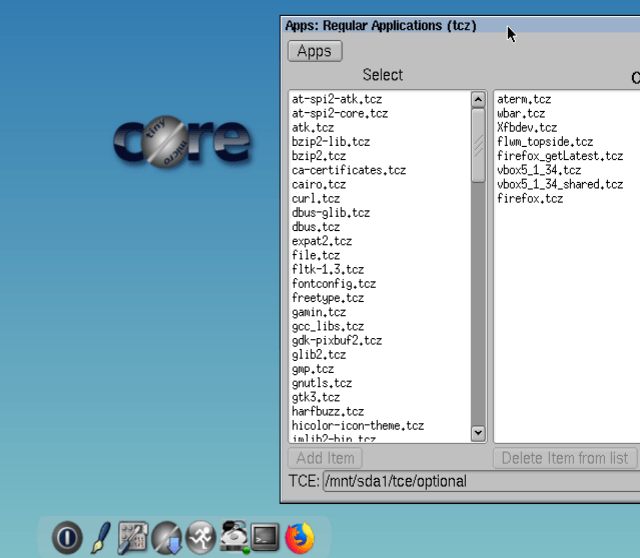
|
As you can see, the on boot loaded Tiny Core packages contain a Xfbdev X server, required for Seoul, and the self-build vbox5 packages, which contain the kernel drivers of the guest additions and the shared folder support. The firefox_getLatest package is shipped by Tiny Core with which you can download and package the latest Firefox yourself, which results in the firefox.tcz package.
The Xfbdev server is not sufficient to get the guest additions running for VBox5. So, I added to /opt/bootsync.sh a short script, that loads during boot the Xorg X server. You may notice it during the boot by the following mesages:
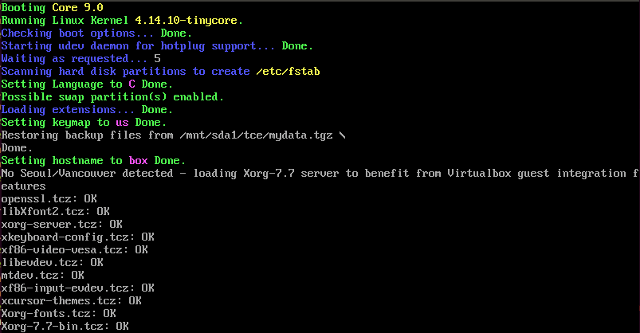
|
The final raw VM image of Tiny Core and Firefox are in the order of 128M-150M, which is the best I could come up. The very same image can now be used for Seoul as VBox5.
The both ready to use Sculpt packages I named firefox@seoul and firefox@vbox5. When started, they spawn a sub-init and as first task the mentioned VM image is completely loaded into RAM from your depot that is accessible solely read-only. As soon as the image is ready, the actual VMM is started and the VM gets bootstrapped and running. The whole VM is just kept in RAM and has no access to persistent storage. When you click in the live graph of the running firefox@seoul or firefox@vbox5 components and remove the instances, all memory of the VM and VMM and all downloaded good or bad content vanishes.
The choice
The very same image runs on our port of Virtualbox (VBox5) and on a VMM called Seoul. The question may come up, why you should bother ? What is Seoul ?
First, if you bother about code you have to trust in order to get things running - the trusted computing base (TCB) - you will notice some difference. If you look at the Lines of Code (LOC) of VBox5, you will notice that they sum up to more than 1 Million LOC. For Seoul the counter stops at 25.000 LOC.
Second, if you run the VM in both VMMs after each other, you will notice some noticeable subjective performance difference. The very same VM will be quiet more snappy and responsiveness with the right VMM.
Just try out.
Or/and read about in the Eurosys 2010 paper. Seoul is a project originated/renamed out of the Vancouver project, originally developed by my former university collogue Bernhard Kauer. The final results are documented in his dissertation, in the mentioned Eurosys 2010 paper, and also some low level graphs as part of the NOVA user land (NUL) documentation.
However, to clearly name the benefits of VBox5, the guest integration features are quite nice in daily work and also much more guests are supported in principal, like Windows 7/10, various Linux distributions, and also 64bit guests.
The instructions
Please setup a window manager on Sculpt CE - a base guide was posted on the mailing list.
Afterwards you may install the disposal VM images.
-
Connect to the network, which is needed to install software.
-
In the + menu, go to "Depot... -> Selection ... " and select the my user name "alex-ab"
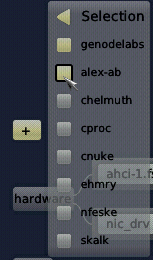
|
-
To select a VM, select in the + menu, "Depot... -> alex-ab -> Virtual machines...":
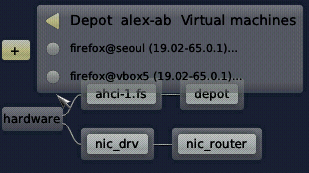
|
-
Select "firefox@seoul" for the Seoul version and connect as follows:
-
Network -> nic router
-
ROM (platform info) -> platform information
-
GUI -> themed wm
-
Region maps -> custom virtual memory objects
-
Real-time clock -> system clock
-
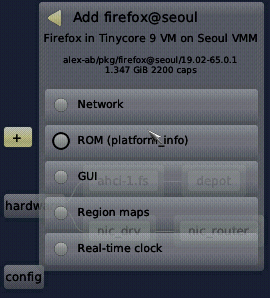
|
For the VBox5 version, further steps are needed:
-
Start the "shared_fs" component. This chroot instance provides the <sculpt-partition>/shared/ directory as a file system.
-
Start the "usb_devices_rom" component from the + menu, which can be used to assign USB devices to the VM.
-
To add the VM, select "Depot... -> alex-ab -> Virtual machines... -> firefox@vbox5" and connect it as follows:
-
File system (shared) -> shared fs
-
GUI -> themed wm
-
Network -> nic router
-
ROM (capslock) -> global capslock state
-
ROM (platform info) -> platform information
-
ROM (usb devices) -> usb devices rom
-
Report (shape) -> themed wm
-
Report -> system reports
-
Region maps -> custom virtual memory objects
-
Real-time clock -> system clock
-
USB -> direct USB device access
-
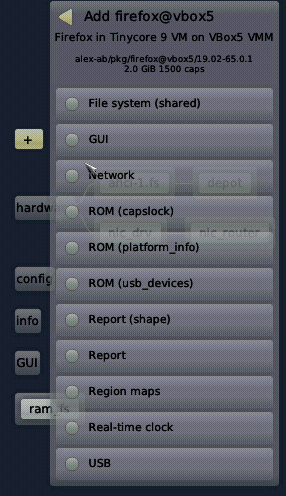
|
The update plan
I tend to update the images whenever I notice that Tiny Core and or Firefox get new versions, which will result in new updated Sculpt packages with a new version. Currently, the version name consists of the Sculpt version and the Firefox version, e.g. 19.02-65.0.1. I try to keep the schema for next updates.
As you may notice, the images are still based on Tiny Core 9 and not on the current Tiny Core 10. The main hassle is that the VBox5 guest additions for our supported VBox5 VMM (version 5.1.36) don't build anymore with newer Linux kernel versions as used by Tiny Core 10.
I succeeded to build and re-package the guest additions when using 5.2.* versions, but unfortunately the shared folder support stopped to work. Because of that, I'm currently settled on Tiny Core 9.


 Alexander Böttcher
Alexander Böttcher